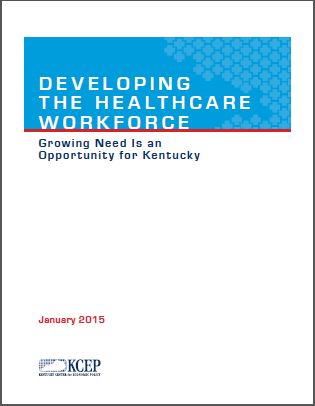 The healthcare sector in Kentucky—and in the U.S.—has been growing for years and will continue to grow, in part due to the Affordable Care Act (ACA) and an aging population. A report released today by the Kentucky Center for Economic Policy (KCEP) highlights an important strategy to meet many of these workforce needs: building ladders of opportunity for low-skilled adults to access the new healthcare jobs.
The healthcare sector in Kentucky—and in the U.S.—has been growing for years and will continue to grow, in part due to the Affordable Care Act (ACA) and an aging population. A report released today by the Kentucky Center for Economic Policy (KCEP) highlights an important strategy to meet many of these workforce needs: building ladders of opportunity for low-skilled adults to access the new healthcare jobs.
“The growth in healthcare jobs, many of which require only a two-year or four-year degree, is an important opportunity for our state,” said KCEP Research and Policy Associate Ashley Spalding, the report’s author. “The challenge is how to fill the growing need for healthcare workers and make the opportunities open to all Kentuckians.”
Healthcare support occupations in Kentucky—such as nursing aides, home health aides and medical assistants—are projected to grow 25 percent between 2010 and 2020, an increase of just over 13,300 jobs. And healthcare practitioners and technical occupations—including registered nurses, respiratory therapists, and medical and clinical laboratory technologists—are also projected to grow 25 percent, an increase of just over 19,500 jobs.
Some of the expected growth in healthcare jobs is due to the ACA, with more people seeking care now that they are insured. The Medicaid expansion alone has been projected to create nearly 17,000 jobs by 2020. Kentucky’s aging population is also leading to growth in healthcare workforce needs—with the state projected to have nearly 1.3 million people age 60 and over in 2030 (up from 829,000 in 2010)—spurring a need for long-term care providers such as home health aides, among other healthcare workers.
“Given Kentucky’s high rates of unemployment and large share of working families that are low-income, the state should take full advantage of this opportunity,” said Spalding.
In order to meet the demand for healthcare workers, and make the opportunities accessible to currently low-skilled Kentuckians, the report advocates for the state to build on the community college system’s experience with career pathways—a workforce development model that provides educational “pathways” that start with a low level of education and end with a better-paying job, with students receiving targeted supports and earning credentials that build along the way.
The full report is available here: “Developing the Healthcare Workforce: Growing Need Is an Opportunity for Kentucky.”
###


